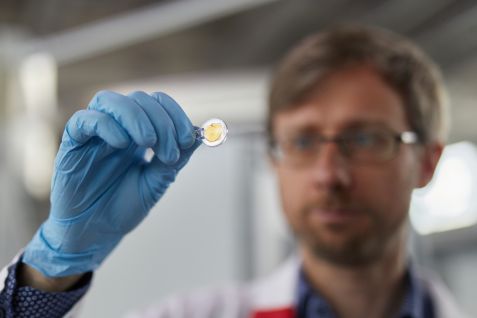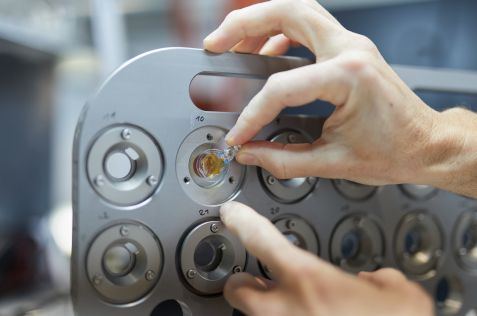MLZ is a cooperation between:
 > Technische Universität München
> Technische Universität München > Helmholtz-Zentrum Hereon
> Helmholtz-Zentrum Hereon
 > Forschungszentrum Jülich
> Forschungszentrum Jülich
MLZ is a member of:
 > LENS
> LENS > ERF-AISBL
> ERF-AISBL
MLZ on social media:

MLZ (eng)
Lichtenbergstr.1
85748 Garching
17.08.2023
Organogels: New cleaning agent for artworks
The restoration of artworks often involves solvents which have toxic properties. Now researchers have succeeded for the first time in creating a non-toxic and sustainable cleaning agent for paintings. Scientists at the Technical University of Munich (TUM) Research Neutron Source Heinz Maier-Leibnitz (FRM II) investigated the structure of the agent, referred to as an organogel.

Scientist Sebastian Busch prepares gel samples with various organic solvents for the neutron scattering experiment. © Bernhard Ludewig/ FRM II
Artistically valuable paintings are irreplaceable, unique works which should be preserved for future generations. However, with the passing of the years they tend to become dull. The reason: A patina of dust, soot, aggressive air pollutants and microorganisms makes the surfaces of the painting look dark and muted. “In order to remove the patina from water-sensitive surfaces, restorers usually use liquid organic solvents which are however hazardous to humans and are also a burden on the environment,” says Prof. Piero Baglioni, chemist at the University of Florence. Ever since beginning his studies he has worked on the restauration of artworks.
Together with an international research team, the scientist has now developed a cleaning agent for paintings which is non-toxic, environmentally friendly and sustainable. The main component of the cleaning agent is castor oil, a natural product which is inexpensive to obtain. Stiff gels can be made from castor oil using certain synthesis processes.

Neutrons are imperative to understand the structure and dynamics of organogels. © Bernhard Ludewig/ FRM II
Gels can carry solvents
These organogels have the special property of being able to integrate organic solvents in their molecular networks: “The gels carrying the solvent can be used to clean works of art without further protective measures: The restorer can apply the organogels and then, after letting them work for a while, can remove them again together with the dust and dirt which has accumulated on the surface. The procedure is very low-impact, since the solvents remain in the gels and are not able to penetrate surface structures,” Baglioni explains.
But: How are the organogels structured and how does this structure change when they carry solvents? This question can’t be answered using classical investigative methods.
Neutrons render the structure of the organogels visible
The answer to this question comes from the Research Neutron Source Heinz Maier-Leibnitz (FRM II) at the TUM Garching campus. Neutrons, whose wavelengths are shorter than the wavelengths of light, can be used to reveal structures of only a few nanometers in size. “Neutrons are absolutely necessary in order to understand the structure and dynamics of the organogels,” Baglioni points out.
His team used the SANS-1 instrument, a special measuring device for Small-Angle Neutron Scattering” (SANS). “Until now there has been little research on organogels. The investigations at FRM II reveal for the first time their nanostructure and provide information on how the structure changes when the polymers are charged with organic solvents,” says Baglioni.
The team used the results of the investigation to optimize the new cleaning agent. In a practical test, restorers at the Peggy Guggenheim Museum in Venice were given a stiff organogel as well as a container full of the solvent. The components are easy to store, can be mixed as needed and applied to paintings. The new cleaning agent was recently used to successfully restore a painting by Giorgio de Chirico which had been difficult to clean using conventional methods.
Publication:
Giovanna Poggi, Harshal D. Santan, Johan Smets, David Chelazzi, Daria Noferini, Maria Laura Petruzzellis, Luciano Pensabene Buemi, Emiliano Fratini, Piero Baglioni,
Nanostructured bio-based castor oil organogels for the cleaning of artworks,
Journal of Colloid and Interface, Science, Volume 638, 2023, Pages 363-374,
ISSN 0021-9797, https://doi.org/10.1016/j.jcis.2023.01.119
More information:
The research was done at: Department of Chemistry “Ugo Schiff” and CSGI, University of Florence, Italy, European Spallation Source ERIC, Lund, Sweden, Jülich Centre for Neutron Science at Heinz Maier-Leibnitz Zentrum, Forschungszentrum Jülich GmbH, Garching, Germany, Peggy Guggenheim Collection, Venice, Italy. The Procter & Gamble Company , Brussels, Belgium provided a fellowship to Harshal Santan, a student working to the synthesis of the preliminary gel.
Contact:
Professor Piero Baglioni
University of Florence
The Chair of Physical Chemistry
baglioni@csgi.unifi.it
+39 055 457-3033
https://www.csgi.unifi.it/person.php?p=28
MLZ is a cooperation between:
 > Technische Universität München
> Technische Universität München > Helmholtz-Zentrum Hereon
> Helmholtz-Zentrum Hereon
 > Forschungszentrum Jülich
> Forschungszentrum Jülich
MLZ is a member of:
 > LENS
> LENS > ERF-AISBL
> ERF-AISBL
MLZ on social media:



